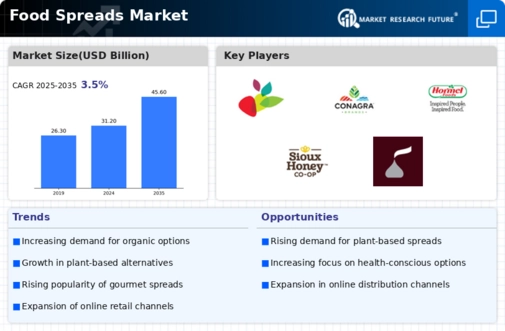Food Spreads Size
Food Spreads Market Growth Projections and Opportunities
The dynamics and growth patterns of the Food Spreads market are impacted by a wide range of factors. Changing consumer breakfast habits and preferences are one of the main drivers of this market. In the process of changing their breakfast routines, consumers look for something to spread on their toast, bagels and other breakfast foods that is handy and flexible. This is why food spreads such as jams, jellies, nut butters and chocolate spread have become important in many homes because they are easy to use while giving a taste to morning meals.
Food Spreads market is influenced significantly by health consciousness. The growing emphasis on healthier eating has resulted in increased demand for spreads that align with wellness goals. This has led to a boom in the popularity of nut butters specifically those made from almonds, peanuts, or other nuts which are seen as nutritious alternatives without added sugars compared to traditional spreads. In response to this trend, companies have been introducing healthier formulations such as reduced sugar or natural sweeteners targeting health-conscious consumers.
The global shift towards plant-based diets coupled with veganism rise also contributes significantly to growth in Food Spreads market. Plant-based spreads like fruit preserves, hummus or vegetable-based ones have gained prominence due to consumers shifting away animal derived products. This change in dietary preferences resonates with ethical, environmental and health considerations hence manufacturers are diversifying their range by incorporating plant-based spreads into their product lines in order to meet the growing demand.
Product diversity and flavor innovations greatly impact on the shape of Food Spreads market. They want unique flavors when it comes to them consuming different kind of spreads because they like new experiences concerning taste buds at this time than ever before causing a high demand for exotic tastes through these groups who love trying out different things. Thus, producers have come up with new combinations such as fruit-infused nut butters, spicy jams and gourmet chocolate spreads. This focus on varied and interesting flavors helps keep the industry alive and attracts consumers who love experiencing new tastes.
The Food Spreads market is also influenced by packaging innovations and sustainability efforts. Some companies have opted to use environmentally friendly packaging materials like glass jars or recyclable ones. In addition, modern consumers are inclined towards on-the-go and portion-controlled options, hence the popularity of convenient sachets that contain single servings.
Economic factors such as income levels and consumer spending determine whether Food Spreads market will be preimmunized. Premium and artisanal spreads are targeted at affluent clients who have more money to spend on gourmet foodstuffs. The market caters to a wide range of customers as it offers cheaply priced spreads as well as high-end brands thus accommodating people with different buying capabilities.
The global Food Spreads market is affected by global supply chain dynamics such as availability of raw materials including their pricing aspects. Changes in the cost of ingredients like fruits, nuts or cocoa can affect production costs for spreads overall. Moreover, weather patterns and geopolitical activities in key sourcing areas may impact the supply chain consequently causing price changes and variations in product availability there too.
There is a big role that consumer education and awareness campaigns play when it comes to influencing buying decisions in the Food Spreads market. Health professionals, nutritionists, and food bloggers have also contributed to public education on nutritional benefits of these food spreads and how they can be used in a healthy diet. This enables consumers become more aware about the ingredients, sourcing and health implications of spreads which lead them into making choices that are aligned with their preferences and goals.
The competitive landscape is made up of factors such as brand recognition, marketing strategies, and product positioning. Established brands will often use their track record to keep hold of their market share while smaller artisanal brands may focus more on distinctive selling points and premium quality. With regard to brand visibility and customer loyalty therefore, marketing should focus on naturalness of ingredients used in making spreads, sustainable sourcing among other things.
The Food Spreads market is also influenced by cultural preferences. Different regions have unique taste preferences leading to variations in the types of spreads that gain popularity. For instance, some regions may prefer fruit preserves with lower sugar contents as opposed to spicier or savory ones for others thus understanding these cultural nuances becomes essential for manufacturers intending to succeed in diverse markets.










Leave a Comment